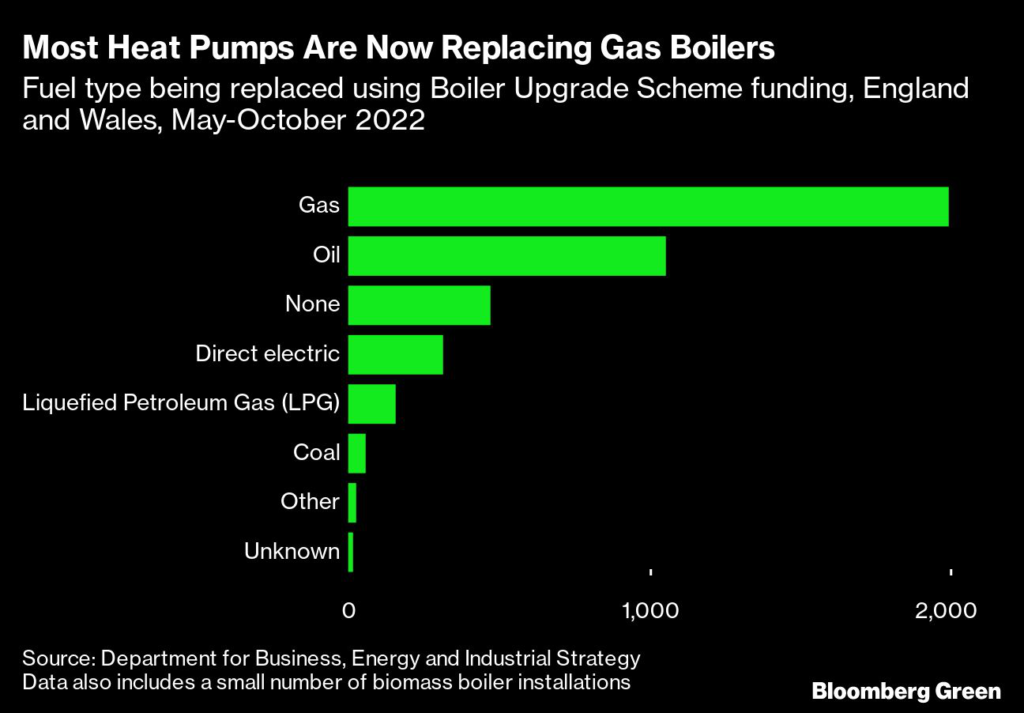Since May, heat pumps in the UK have predominantly replaced gas boilers, an important segment with implications for the clean-energy transition.
(Bloomberg) — For most of the past 15 years, heat pumps in the UK have mostly been installed in rural areas, where they tend to replace oil-fired central heating. This year, though, the European energy crunch is upending that trend: An analysis of government data shows that since May, heat pumps in Britain have predominantly replaced gas boilers.
Just under half of heat pump installations between May and October were in homes previously heated with gas, while one in four were in homes heated with oil. The introduction in May of a £5,000 grant towards the cost of a heat pump — as well as a now-expired program that offered homeowners quarterly payments to install low-carbon technologies — are also poised to push UK heat pump installations above 2021 levels this year, albeit only narrowly. The government’s target is for 600,000 new heat pumps to be installed each year by 2028, and adoption will have to speed up significantly to meet that goal.
Replacing gas- or oil-powered heating with an electric heat pump is beneficial from an emissions perspective: Estimates by the nonprofit Energy Saving Trust suggest one kilowatt hour of energy from gas yields 208g of carbon dioxide, compared to 298g for oil. But the shift to replacing gas boilers could also have implications for the wider clean-energy transition: Some 85% of homes in the UK are heated with gas.
Heating oil has long been used for UK properties not connected to the gas grid, and it has historically been more expensive than electricity — a disparity that made switching to an electric heat pump appealing when an oil boiler did conk out. Between 2008 and March of this year, 82% of heat pumps in Britain went to homes off the gas grid, according to Nesta, the research agency that carried out the analysis.
As a result, there are around 4.8 times more heat pumps in homes off the gas grid than on it, particularly in remote areas like Cornwall, which at 12,000 has the largest number of heat pumps in any council area; and the Highlands and Islands of Scotland, which has the highest density of the devices.
“Rural areas have been leading the way on low-carbon heating in the UK. However, the energy crisis has reversed the economics of oil-fired heating,” says Andrew Sissons, deputy director for sustainable future at Nesta. Indeed, while heating oil prices have roughly doubled since 2021, gas prices have more than tripled. (Electricity prices are likewise way up, though not as much as gas.)
Heat pump adoption remains challenged by the nature of Britain’s housing stock. Older properties often need extra insulation for heat pumps to work effectively, at additional upfront cost to the homeowner. The UK also lacks enough trained workers for the number of heat pump installations the government is hoping for.
As Europe’s energy crunch drags on, the current trend may not last. Sissons says the inefficiency of heating oil — it has to be transported to rural properties, which also tend to be more difficult to heat — will continue to make heat pumps an appealing alternative for those homes. Meanwhile, tests are underway in some areas to blend gas and hydrogen power through the existing gas grid, although inefficiency and cost remain challenges. Other shifts may emerge from a report to be published next year by former UK energy minister Chris Skidmore, on policies to get to net zero. Already, gas and oil heating will be banned in all new properties in the country starting in 2025.
More stories like this are available on bloomberg.com
©2022 Bloomberg L.P.










